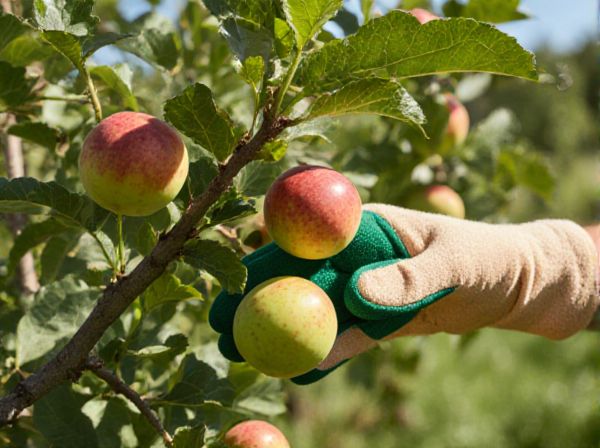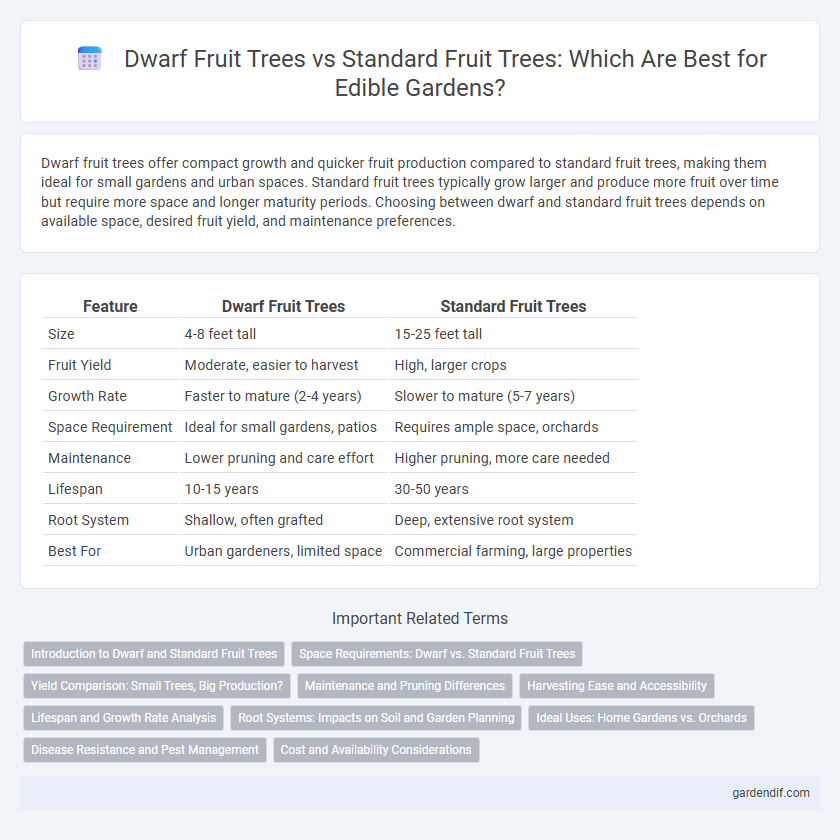
Dwarf Fruit Trees vs Standard Fruit Trees Illustration
Dwarf fruit trees offer compact growth and quicker fruit production compared to standard fruit trees, making them ideal for small gardens and urban spaces. Standard fruit trees typically grow larger and produce more fruit over time but require more space and longer maturity periods. Choosing between dwarf and standard fruit trees depends on available space, desired fruit yield, and maintenance preferences.
Table of Comparison
| Feature | Dwarf Fruit Trees | Standard Fruit Trees |
|---|---|---|
| Size | 4-8 feet tall | 15-25 feet tall |
| Fruit Yield | Moderate, easier to harvest | High, larger crops |
| Growth Rate | Faster to mature (2-4 years) | Slower to mature (5-7 years) |
| Space Requirement | Ideal for small gardens, patios | Requires ample space, orchards |
| Maintenance | Lower pruning and care effort | Higher pruning, more care needed |
| Lifespan | 10-15 years | 30-50 years |
| Root System | Shallow, often grafted | Deep, extensive root system |
| Best For | Urban gardeners, limited space | Commercial farming, large properties |
Introduction to Dwarf and Standard Fruit Trees
Dwarf fruit trees typically reach heights of 8 to 12 feet, making them ideal for small spaces and container gardening, while standard fruit trees can grow over 20 feet tall, requiring larger orchards or yards. Dwarf varieties produce fruit earlier, often within 2 to 3 years of planting, compared to standard trees that may take 5 to 7 years to bear fruit. Both types offer diverse species including apples, cherries, and citrus, catering to different cultivation needs and harvest volumes.
Space Requirements: Dwarf vs. Standard Fruit Trees
Dwarf fruit trees require significantly less space, typically needing about 8-10 feet of spacing compared to 18-25 feet for standard fruit trees. Their compact root systems and smaller canopy make them ideal for small gardens, patios, or urban settings where space is limited. Standard fruit trees, with sprawling branches and deeper roots, demand larger plots to thrive and avoid overcrowding that can reduce fruit quality.
Yield Comparison: Small Trees, Big Production?
Dwarf fruit trees typically produce a higher yield per square foot compared to standard fruit trees due to their compact size and more intensive planting density. While standard trees offer larger individual fruit harvests, their expansive canopy limits the number of trees per acre, reducing overall productivity. Optimizing dwarf varieties can lead to big production on smaller plots, making them ideal for home gardens and commercial orchards with limited space.
Maintenance and Pruning Differences
Dwarf fruit trees require less maintenance and simpler pruning routines compared to standard fruit trees due to their smaller size, which facilitates easier access and reduces time spent on shaping and thinning branches. Standard fruit trees often demand more intensive pruning to manage their larger canopies, improve air circulation, and ensure sunlight penetration, which is essential for healthier fruit production. Maintenance tasks such as pest control, fertilization, and harvesting are also more manageable with dwarf varieties, making them ideal for limited spaces and home gardens.
Harvesting Ease and Accessibility
Dwarf fruit trees offer easier harvesting due to their compact size, allowing fruit to be reached without ladders or extensive equipment, making them ideal for small gardens and accessible for elderly or physically limited individuals. Standard fruit trees often require climbing tools or ladders, increasing harvesting difficulty and safety risks, especially for taller varieties like apple, pear, or cherry trees. The manageable height and pruning ease of dwarf trees enhance fruit accessibility and reduce labor intensity during the harvest season.
Lifespan and Growth Rate Analysis
Dwarf fruit trees typically have a shorter lifespan of around 20 to 25 years compared to standard fruit trees, which can live 40 to 50 years or more. Dwarf varieties reach maturity and begin producing fruit faster, often within 2 to 4 years, whereas standard trees may take 5 to 7 years. The compact growth rate of dwarf trees allows for quicker harvest cycles, making them ideal for limited space and intensive gardening.
Root Systems: Impacts on Soil and Garden Planning
Dwarf fruit trees have compact root systems that penetrate less deeply and spread less extensively than standard fruit trees, resulting in reduced soil disturbance and easier garden integration. Their shallow roots minimize competition with nearby plants and allow for more precise placement within limited spaces or raised beds. Standard fruit trees develop extensive root networks, which improve soil aeration and nutrient cycling but require more careful planning to avoid interference with structures and underground utilities.
Ideal Uses: Home Gardens vs. Orchards
Dwarf fruit trees are ideal for home gardens due to their compact size, allowing for easier maintenance, quicker fruit production, and suitability for limited spaces such as patios or small yards. Standard fruit trees are better suited for orchards where larger spaces facilitate extensive farming operations, higher yield potential, and commercial-scale harvesting. Home gardeners benefit from dwarf varieties with manageable growth habits, while commercial growers rely on standard trees for maximizing fruit volume and long-term production.
Disease Resistance and Pest Management
Dwarf fruit trees exhibit enhanced disease resistance due to their compact size, allowing for better air circulation and easier monitoring for pests and diseases compared to standard fruit trees. Their smaller stature facilitates targeted pest management strategies, reducing the need for broad-spectrum pesticides and promoting healthier fruit production. Standard fruit trees often require more intensive treatments and vigilance, as their larger canopy can harbor pests and diseases more extensively.
Cost and Availability Considerations
Dwarf fruit trees typically cost more upfront than standard fruit trees but save space and are often available at specialty nurseries or online, catering to urban gardeners. Standard fruit trees, generally less expensive and widely available at local garden centers, require more space and longer maturation periods. Budget-conscious growers with limited space often prefer dwarf varieties despite the higher initial investment due to their manageable size and quicker fruit yield.
Dwarf Fruit Trees vs Standard Fruit Trees Infographic

 gardendif.com
gardendif.com